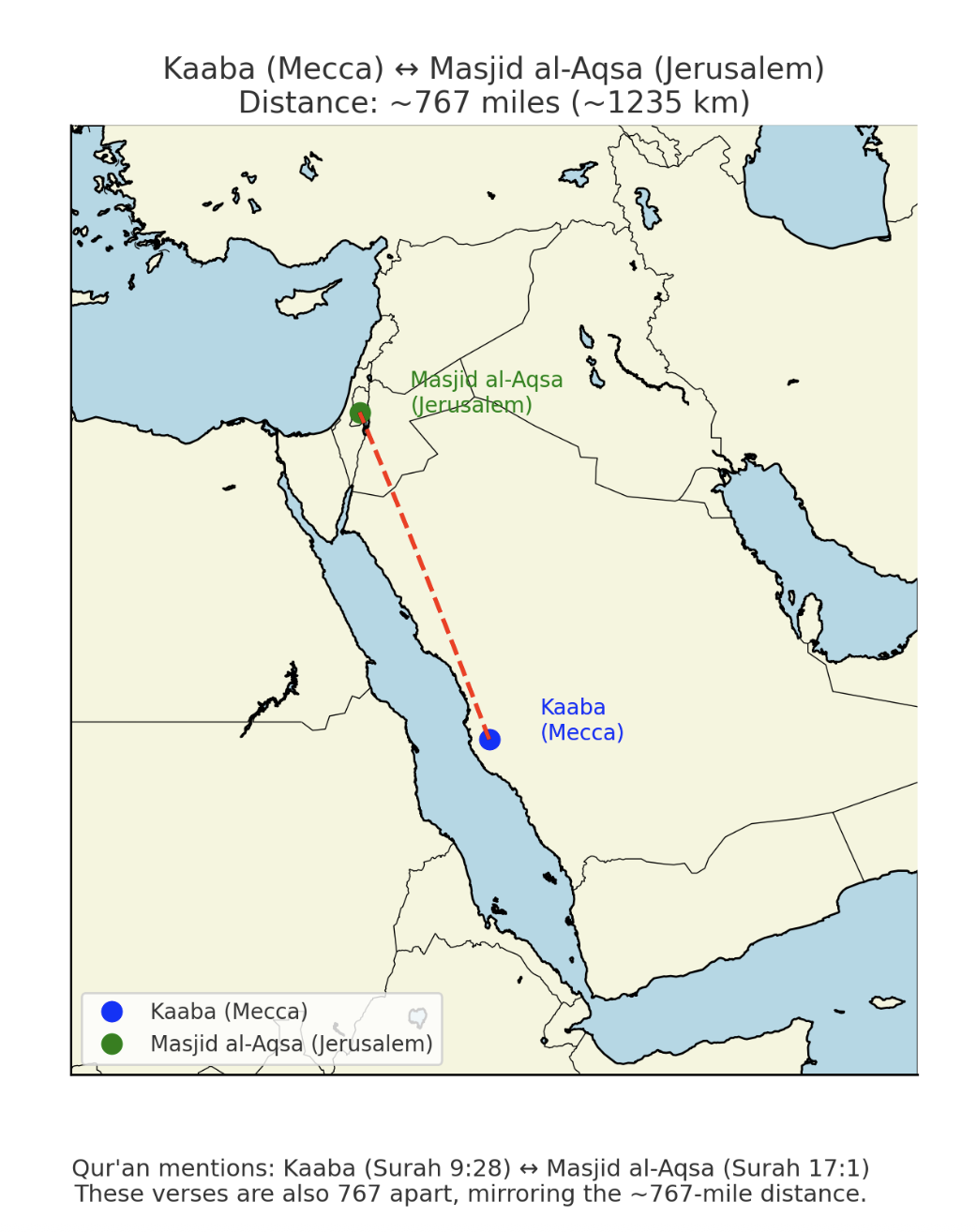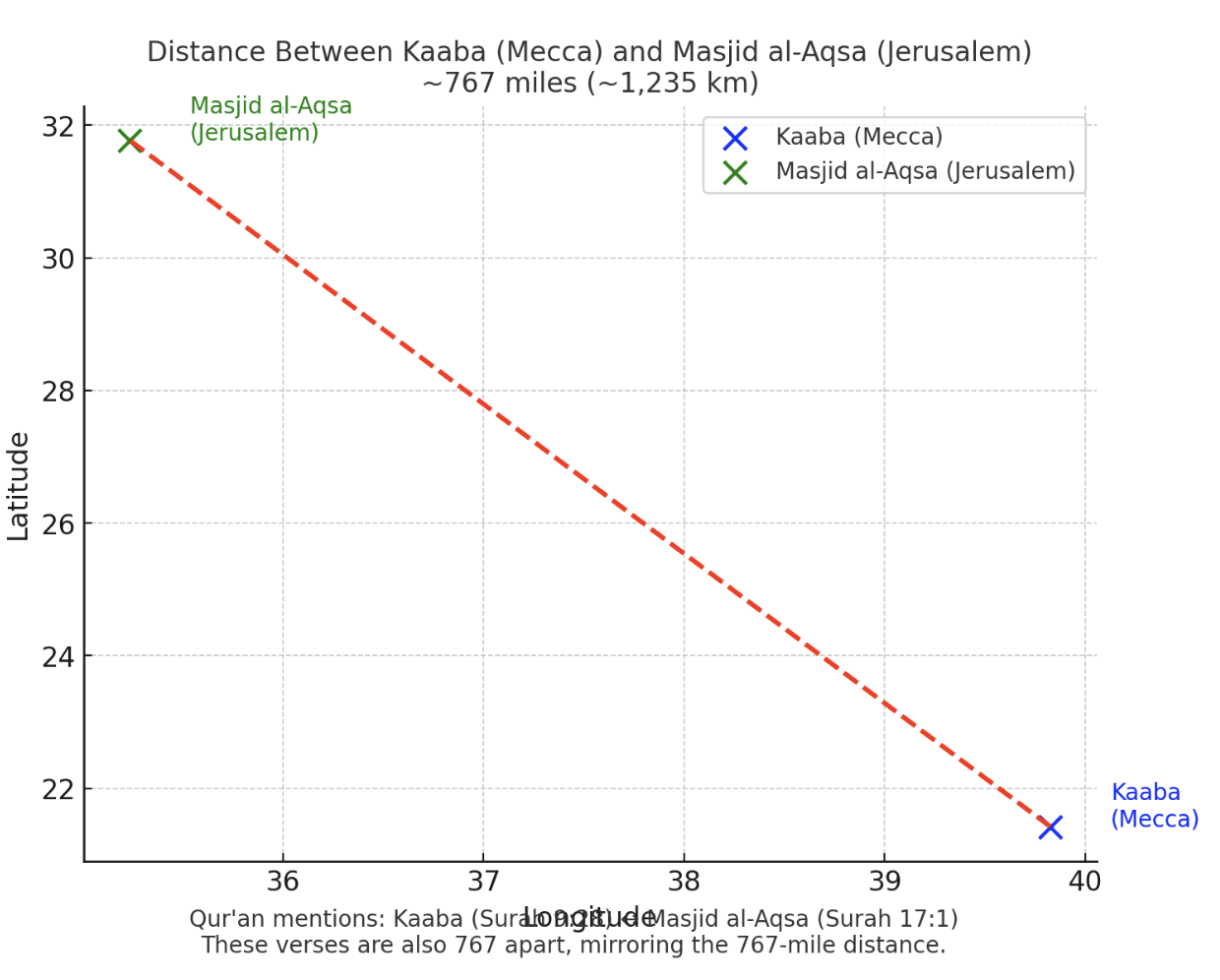SURAH AT TAWBAH VERSE 28 / SURAH AL-ISRA VERSE 1

The Quran is filled with tremendous examples of science, history, linguistics, mathematics, among many other topics. Geography and numerals also are interesting signs for those with open eyes and hearts. I already discussed a fascinating example of kilometers in the Quran in the article – Iron to the Core – which is the most common measure of large distances in the Eastern world. Now let us focus on the Mile – the most common measure of large distances in the US and UK.
Since the dawn of Islam, two of the most renowned sacred sites have held profound spiritual, historical, and theological significance for Muslims around the world: the Kaaba in Mecca and Masjid al-Aqsa in Jerusalem. Each embodies key dimensions of the Muslim faith—unity, prophecy, worship—and both remain focal points of pilgrimage, prayer, and devotion.
The Kaaba, located within the Masjid al-Haram in Mecca, is the most sacred structure in Islam. It is often called Bayt Allāh (the House of God) and serves as the qiblah, the direction toward which Muslims face in every ritual prayer, wherever they may be (Wikipedia).
Built originally by Prophet Abraham (Ibrāhīm) and his son Ishmael (Ismā‘īl), the Kaaba has been a symbol of monotheism and submission to God. Over time, it became the central point for the ritual of Hajj—one of the Five Pillars of Islam—during which millions of Muslims converge annually to perform tawāf (circumambulation) around it.
The Qur’an itself highlights the Kaaba’s sanctity in Surah At-Tawbah (9:28), where it is described as al-Masjid al-Ḥarām, the Sacred Mosque, emphasizing its central role in the life of the Muslim community.
Masjid al-Aqsa, often referred to simply as al-Aqsa, is among Islam’s holiest sites, located in the Noble Sanctuary (al-Ḥaram al-Sharīf) in Jerusalem. It is the third holiest site in Islam, after the Kaaba in Mecca and the Prophet’s Mosque in Medina (Wikipedia).
Its significance is multifaceted:
- The Night Journey (Isrā’) and Ascension (Miʿrāj): Islamic tradition holds that Prophet Muhammad was miraculously transported from the Sacred Mosque in Mecca to al-Aqsa during the Night Journey, and then ascended through the heavens. This pivotal event is directly referenced in Surah Al-Isrā’ (17:1).
- First Qibla: Before the direction of prayer was permanently fixed towards the Kaaba, Muslims initially faced Masjid al-Aqsa in their prayers, underscoring its importance in the early development of Islamic worship (MuslimPro).
- Blessing and Sanctity: The Qur’an refers to al-Aqsa’s precincts as “blessed.” Its sanctuary is revered not only for these early prophetic events but as a symbol of continuity with earlier prophets in Islam’s tradition of monotheism (Human Appeal).
A Striking Correlation
The geographic distance between the Kaaba in Mecca and Masjid al-Aqsa in Jerusalem is 767 miles (1,235 km). Remarkably, the Qur’anic mention of the Kaaba in Surah 9:28 and the mention of Masjid al-Aqsa in Surah 17:1 are also 767 verses apart!


This striking parallel between physical geography and scriptural sequence has long fascinated scholars and believers alike. It reflects the subtle harmony woven into the Qur’an and underscores the profound, divinely guided connection between these two sanctuaries.
The Kaaba and Masjid al-Aqsa together knit together Islam’s identity in time and space: the Kaaba binds Muslims through daily prayer and the pilgrimage that renews/sharpens faith, while al-Aqsa links them to prophetic history, to Jerusalem that spans Judeo-Christian tradition as well.
For believers, they are not only physical places but spiritual centers that invite reflection—on Allah’s oneness, on the continuity of prophetic messages (prior to man’s influence/bias), and on the unity and diversity of the global Muslim community. For those that have open minds and hearts – this remarkable correlation of distance serves as yet another marker of the divine!
